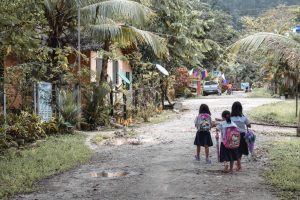Several recent studies have pointed out the alarming deterioration of the quality of learning in the Philippines, but this was officially confirmed in the basic education report delivered by Vice President Sara Duterte on January 30. Duterte is concurrently serving as secretary to the Department of Education.
Addressing stakeholders with President Ferdinand Marcos Jr. in attendance, Duterte highlighted the key issues that plague the country’s basic education system before announcing her department’s agenda for reform.
She echoed what previous surveys have indicated about the low academic proficiency of Filipino students. She also identified her department’s biggest concern. “The lack of school infrastructure and resources to support the ideal teaching process is the most pressing issue pounding the Philippine basic education,” she said.
She presented the latest government inventory which shows that out of 327,851 school buildings in the country, only 104,536 are in good condition. There are 100,072 school buildings that need minor repairs, 89,252 that require major repairs, and 21,727 that are set for condemnation.
She added that the procurement practices in the agency “had red flags that demanded immediate actions.” She shared initial findings in the ongoing review of the K-12 curriculum that underscored the failure of the 10-year-old program to deliver satisfactory results.
“The K-12 curriculum promised to produce graduates that are employable. That promise remains a promise,” she said.
Duterte criticized the heavy workload assigned to teachers as she pressed for an immediate review of the current setup in public schools. “This is a system that burdens them with backbreaking and time-consuming administrative tasks, a system that provides no adequate support and robs them of the opportunity to professionally grow and professionally teach, assist, and guide our learners,” she said.
She unveiled her education agenda themed “Matatag: Bansang Makabata, Batang Makabansa,” (Nation for children, children for the nation) and focused on curriculum reform, accelerated delivery of services, promoting the well-being of learners, and providing greater support to teachers.
Responding to the report, Marcos joined Duterte in acknowledging the government’s accountability to the nation’s young learners. “We have failed them,” he said. “We have to admit that. We have failed our children and let us not keep failing them anymore.” He promised to build better infrastructure by investing heavily in education.
He can cite as reference his government’s development plan, which was also released in January, about how the education crisis is linked to “decades of incapacity and suboptimal investment in education.”
Duterte’s admission about the dismal state of basic education was welcomed by some educators. Senators vowed to work with Marcos and Duterte in passing education reform measures. Opposition legislators urged Duterte to hear the views of school unions and student organizations whose appeals for better learning conditions are often dismissed by authorities as part of anti-government propaganda.
Meanwhile, the Alliance of Concerned Teachers (ACT) noted that the report “failed to present today’s real extent and gravity of the learning crisis due to the lack of an evidence-based learning assessment conducted after the pandemic-induced school lockdowns.” The group was referring to the prolonged closure of schools under the government of President Rodrigo Duterte.
“Her father was president for six years and had not done any significant move to improve the lot of our mentors and of the education system. It is the government who have failed the teachers and our learners,” the group insisted.
It was also under the Duterte government when around 54 Lumad schools for indigenous peoples in Mindanao Island were either suspended or forced to shut down by authorities based on accusations that they were teaching rebellion.
The report also didn’t mention that some of the major questionable procurement transactions in the education department took place under the previous government.
The ACT criticized Duterte’s reform agenda because it features “general promises that lack specific action plans and definite targets.”
“No specific targets and timelines were presented to convincingly show that the agency will cut down the classroom shortage significantly,” it added.
Duterte said the agency will build 6,000 classrooms this year, which is quite small compared to the backlog identified in the report. There’s also no deadline for the electrification of around 1,562 schools that still do not have access to power.
Despite her impassioned plea to uplift the working conditions of educators, Duterte was castigated for being silent about the pending proposals to raise the salary grades of public school teachers.
ACT reminded officials to prove their political will in reversing the decline of Philippine education. “The call to reforming education should not be a grandstanding cry but a sincere pledge to rectify the mistakes and shortcomings of the past and the present,” it said.
This can be measured in at least two ways this year. First, Duterte’s willingness to file appropriate charges against erring officials involved in anomalous transactions under the previous administration. And second, Marcos’ commitment to substantially increase the funding for education.

































